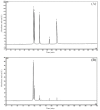Improvement Effect of Lotus Leaf Flavonoids on Carbon Tetrachloride-Induced Liver Injury in Mice
- PMID: 32102401
- PMCID: PMC7169453
- DOI: 10.3390/biomedicines8020041
Improvement Effect of Lotus Leaf Flavonoids on Carbon Tetrachloride-Induced Liver Injury in Mice
Abstract
In this study, the effect of lotus leaf flavonoids (LLF) on carbon tetrachloride (CCl4)-induced liver injury in mice was studied. CCl4 was injected intraperitoneally to induce liver injury in Kunming mice. Mice were treated with LLF by gavage, and the mRNA expression levels in serum and liver were detected. Compared with the model group, LLF significantly reduced the liver index and serum aspartate aminotransferase (AST), alanine aminotransferase (ALT), triglyceride (TG), and total cholesterol (TC) levels in mice with CCl4-induced liver injury. Pathological observation showed that LLF effectively reduced morphological incompleteness and hepatocyte necrosis in CCl4-treated liver tissue. The result of quantitative polymerase chain reaction (qPCR) indicated that LLF significantly up-regulated the mRNA expression levels of copper/zinc superoxide dismutase (Cu/Zn-SOD), manganese superoxide dismutase (Mn-SOD), and catalase (CAT) and down- regulated the expression levels of tumor necrosis factor-alpha (TNF-α), nuclear factor kappa B (NF-κB), and interleukin-1β (IL-1β) (p < 0.05). Thus, LLF is an active ingredient that ameliorates liver injury, and it has good application prospect.
Keywords: carbon tetrachloride; liver injury; lotus leaf flavonoids; mRNA, mice.
Conflict of interest statement
The authors declare no conflict of interest. The funders had no role in the design of the study; in the collection, analyses, or interpretation of data; in the writing of the manuscript, or in the decision to publish the results.
Figures




Similar articles
-
A novel type lavandulyl flavonoid from Sophora flavescens as potential anti-hepatic injury agent that inhibit TLR2/NF-κB signaling pathway.J Ethnopharmacol. 2023 May 10;307:116163. doi: 10.1016/j.jep.2023.116163. Epub 2023 Feb 2. J Ethnopharmacol. 2023. PMID: 36738945
-
Lactobacillus fermentum HFY06 reduced CCl4-induced hepatic damage in Kunming mice.RSC Adv. 2019 Dec 20;10(1):1-9. doi: 10.1039/c9ra08789c. eCollection 2019 Dec 20. RSC Adv. 2019. PMID: 35492553 Free PMC article.
-
Antioxidant Capacity-Related Preventive Effects of Shoumei (Slightly Fermented Camellia sinensis) Polyphenols against Hepatic Injury.Oxid Med Cell Longev. 2020 Aug 19;2020:9329356. doi: 10.1155/2020/9329356. eCollection 2020. Oxid Med Cell Longev. 2020. PMID: 32922655 Free PMC article.
-
Hepatoprotective evaluation of the total flavonoids extracted from flowers of Abelmoschus manihot (L.) Medic: In vitro and in vivo studies.J Ethnopharmacol. 2013 Apr 19;146(3):794-802. doi: 10.1016/j.jep.2013.02.005. Epub 2013 Feb 16. J Ethnopharmacol. 2013. PMID: 23422335
-
Liver Injury Induced by Carbon Tetrachloride in Mice Is Prevented by the Antioxidant Capacity of Anji White Tea Polyphenols.Antioxidants (Basel). 2019 Mar 14;8(3):64. doi: 10.3390/antiox8030064. Antioxidants (Basel). 2019. PMID: 30875793 Free PMC article.
Cited by
-
Evaluation of the Acute and Sub-Acute Oral Toxicity of Jaranol in Kunming Mice.Front Pharmacol. 2022 Jun 30;13:903232. doi: 10.3389/fphar.2022.903232. eCollection 2022. Front Pharmacol. 2022. PMID: 35847023 Free PMC article.
-
Intervention effects of lotus leaf flavonoids on gastric mucosal lesions in mice infected with Helicobacter pylori.RSC Adv. 2020 Jun 19;10(40):23510-23521. doi: 10.1039/d0ra03311a. eCollection 2020 Jun 19. RSC Adv. 2020. PMID: 35517367 Free PMC article.
-
The Manufacturing Process of Lotus (Nelumbo Nucifera) Leaf Black Tea and Its Microbial Diversity Analysis.Foods. 2025 Feb 6;14(3):519. doi: 10.3390/foods14030519. Foods. 2025. PMID: 39942112 Free PMC article.
-
Kahweol Protects against Acetaminophen-Induced Hepatotoxicity in Mice through Inhibiting Oxidative Stress, Hepatocyte Death, and Inflammation.Biomed Res Int. 2022 Feb 27;2022:8121124. doi: 10.1155/2022/8121124. eCollection 2022. Biomed Res Int. 2022. PMID: 35265717 Free PMC article.
References
-
- Yin L.H., Yu H., Peng J.Y. Molecular Mechanism and Intervention of Chinese Medicine of Carbon Tetrachloride Induced Liver Injury. Chin. J. Mod. Appl. Pharm. 2015;32:1147–1155.
-
- Tittarelli R., Pellegrini M., Scarpellini M.G., Marinelli E., Bruti V., di Luca N.M., Busardò F.P., Zaami S. Hepatotoxicity of paracetamol and related fatalities. Eur. Rev. Med. Pharmacol. Sci. 2017;21:95–101. - PubMed
LinkOut - more resources
Full Text Sources
Miscellaneous

